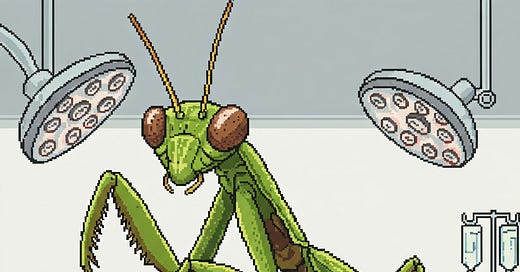My friend — let’s call him Max — is about to smoke DMT.
Candles are lit. Music is on. Everything’s ready to go. And he’s scared.
Max has smoked DMT before. He knows the experience will only last a few minutes and he’ll come out the other side. He knows there’s nothing to be scared of on a practical or physiological level. But that’s as reassuring as telling someone standing next to an open airplane door that skydiving is actually very safe.
Four and a half minutes after taking his last hit1, Max is mostly back to normal, with a huge smile on his face.
“It was great.”
The tension has evaporated from the room as Max recounts his experience. Then someone suggests that he try it again, and his face drops.
“Oh god, I’m scared.”
Knees knocking
If you find the prospect of a high-dose psychedelic experience scary, you’re in good company.
Meditation teacher and former news anchor Dan Harris just wrote about how he’s too scared to try psychedelics. This is a guy who used to speak to millions of people live on camera from war zones.
Terence McKenna said of the difference between contemplative spiritual practices and psychedelic use:
You don’t find people going into the ashram in the morning to meditate with their knees knocking in fear because of how terrifying and profound they know that meditation is going to be. But if they were going in there to smoke DMT, you know, they would be fully riveted on the modalities of what was about to happen.
So yes, psychedelics are really scary. But why?
Medically, DMT and psilocybin are safer than many common drugs. They’re certainly safer than alcohol.
Nobody has to work up courage to drink a glass of wine. So this isn’t about the actual danger psychedelics pose. It’s something else.
Our real shit
We often view fear as an obstacle to overcome. My friend Max was scared of DMT, he overcame that fear, and then he did the thing he was trying to do. Right?
But what if fear is itself an important ingredient in the psychedelic stew?
Tibetan Buddhist weirdo Chögyam Trungpa, who wrote a book on fear, said:
We have a fear of facing ourselves. Experiencing the innermost core of their existence is embarrassing to a lot of people. Many people try to find a spiritual path where they do not have to face themselves but where they can still liberate themselves—liberate themselves from themselves, in fact. In truth, that is impossible. We cannot do that. We have to be honest with ourselves. We have to see our gut, our real shit, our most undesirable parts. We have to see that. That is the foundation of warriorship and the basis of conquering fear. We have to face our fear; we have to look at it, study it, work with it, and practice meditation with it.
To me, “a fear of facing ourselves” lies at the heart of our psychedelic anxieties. Sure, we’re afraid of meeting giant mantis surgeons (which are, bizarrely, a not-uncommon DMT entity encounter), but what we’re really afraid of encountering is a mirror. We’re afraid we’re going to see our true selves in there. Our real shit.
From the perspective of mindfulness, fear isn’t something to be overcome. It’s just another arising condition. But man, it’s an arising condition that holds tremendous power over our day-to-day lives.
So if the thought of taking psychedelics makes us scared — wonderful. By becoming afraid and being aware that we’re afraid, we’re bringing an important emotion into conscious awareness and out of the unconscious, reactive mind where it usually skulks.
That’s why I recommend practicing fear meditation when preparing for a psychedelic experience. This type of meditation — where we intentionally make ourselves fearful of anxious — helps loosen fear’s hold on our attention. We can see that fear is just one more thing happening in consciousness, and that we can be with it in the same way we experience other emotions or the feeling in the body.
We might even get to the place where we welcome fear when it arises. Fear, my old friend, come on in. If we can get there, we can handle anything, psychedelic or otherwise.
So by practicing with the fear of psychedelics, we’re already doing important work. In fact, changing our relationship to fear could prove more transformational than all the mantis surgery in the world.
The body metabolizes DMT extremely quickly with enzyme called monoamine oxidase. This metabolization can be slowed by also taking a monoamine oxidase inhibitor. That’s how ayahuasca works — it’s a combination of a DMT-containing plant with a monoamine oxidase inhibitor-containing plant. Neat.





